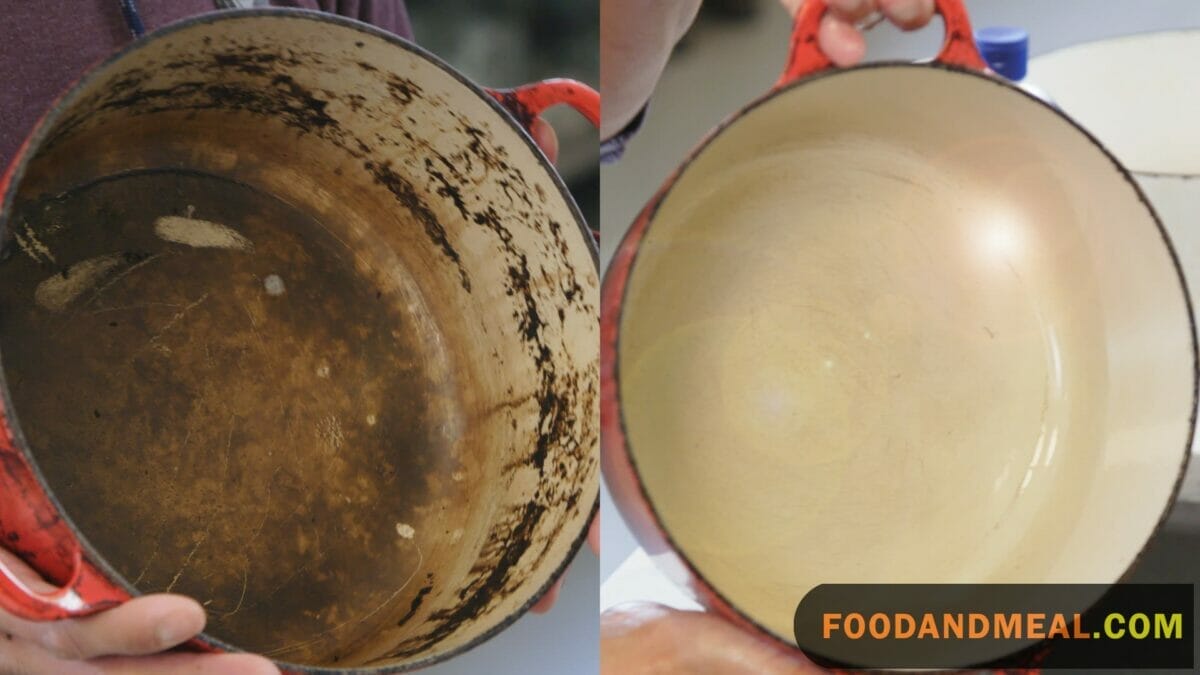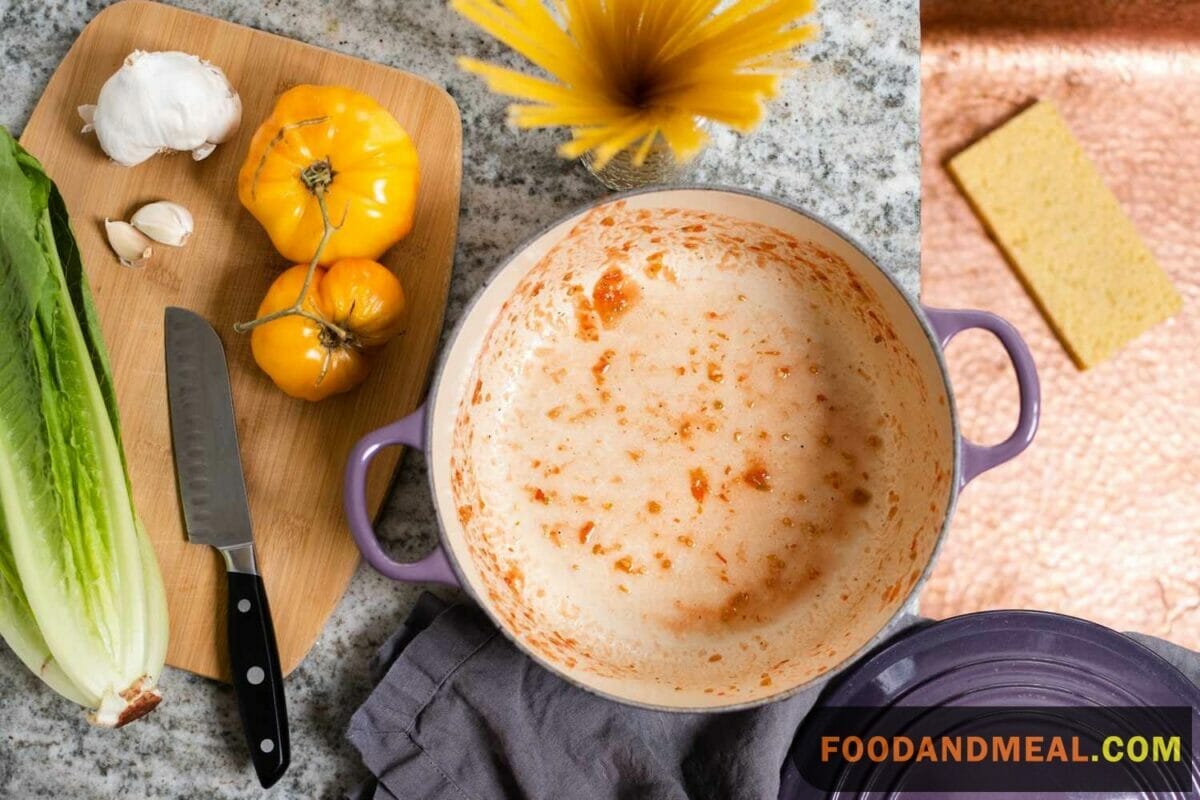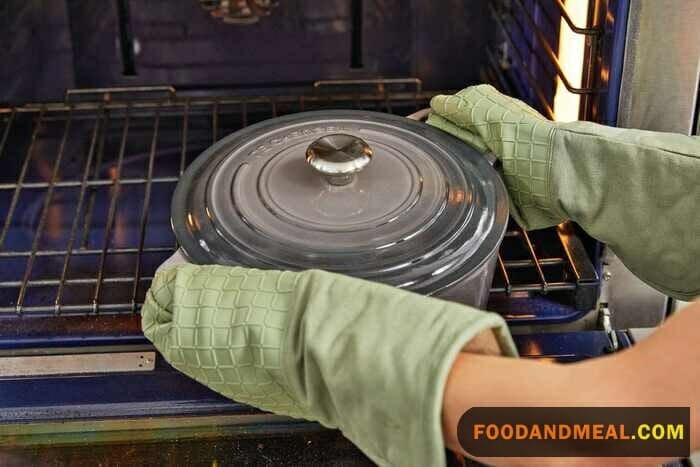Dutch ovens are among the most versatile pieces of cookware in any kitchen. They can be used on a stovetop or in the oven, and there are even models designed for outdoor use over a campfire. With their straight sides and deep design, along with a tightly fitting lid, Dutch ovens are perfect for making soups and stews, simmering pasta sauces, braising meats, baking bread, and serving dishes.
Available at a wide range of prices, the best Dutch ovens are crafted from heavy, durable materials. They come in various materials such as cast iron, enameled cast iron, aluminum with a non-stick interior coating, stainless steel, and ceramic stoneware. Sizes range from individual 1/2 quart ovens to 15-quart ovens large enough to accommodate a turkey.
If you take proper care of your Dutch oven, it can last for generations. The method for cleaning it depends on the type of material used in its construction.

How frequently you should clean a Dutch oven
When it comes to how frequently you should clean a Dutch oven, it’s recommended to give it a thorough cleaning after each use. While solid cast-iron Dutch ovens might not require an extensive scrubbing every time, it’s essential to at least wipe the interior clean after each use.
What You’ll Need
Here’s a list of the items you’ll need to clean a Dutch oven:
Equipment / Tools:
- Non-abrasive plastic scraper
- Non-abrasive sponge or dishcloth
- Microfiber drying cloth
Materials:
- Dishwashing liquid
- Baking soda or a gentle scrubbing powder (such as Bar Keepers Friend or Bon Ami)
- Paper towels
- Vegetable oil
How to Clean a Ceramic Stoneware Dutch Oven
Ceramic stoneware ovens are delicate and can easily break if dropped or subjected to extreme temperature changes, so it’s essential to handle them with care. While it’s technically possible to put a ceramic Dutch oven in the dishwasher, it’s strongly recommended to opt for hand washing, as it’s the preferred cleaning method for preserving its quality.
Here’s how to clean a ceramic Dutch oven effectively:
- Wash in Hot, Soapy Water: After your ceramic Dutch oven has cooled down, begin the cleaning process by washing it with hot water and a mild dishwashing liquid. Be cautious not to use citrus-based cleaners, as they can dull the glossy exterior finish.
- Avoid Scratches: In case of burnt-on food residue, allow the Dutch oven to soak in the soapy solution for several hours. After soaking, use a nylon scrubber to gently remove the food particles. It’s crucial never to employ metal utensils or scouring pads, as they can cause scratches on the ceramic surface, compromising its appearance and integrity.

How to Clean a Stainless Steel Dutch Oven
Stainless steel Dutch ovens offer the advantage of being lightweight and simple to clean.
Here are the steps to effectively clean a stainless steel Dutch oven:
- Wash in Hot, Soapy Water: After the Dutch oven has cooled down enough to handle, place it in a sink filled with hot, soapy water. Thoroughly wash the interior and exterior. Ensure a good rinse to remove any soap residue and dry it immediately to prevent water spots.
- Remove Stuck-on Food with a Baking Soda Boil: If you encounter stubborn, stuck-on food residue, follow this method. Pour four cups of water into the Dutch oven and add two or three tablespoons of baking soda. Bring this mixture to a simmer and allow it to boil for one minute. Afterward, let it cool down and proceed with the regular washing process.
How to Clean a Cast Iron Dutch Oven
Follow these same procedures for cleaning both unfinished indoor and outdoor-use cast iron Dutch ovens:
- Wipe Away Food Residue: When the cast iron oven has cooled to a manageable but still warm temperature, take a paper towel and use it to gently wipe away any food residue from both the interior and exterior surfaces, including the lid.
- For Properly Seasoned Cast Iron: In the case of a well-seasoned cast iron Dutch oven, this might be all the cleaning required.
- Remove Food and Oily Residues: If the interior of the oven has stubborn, stuck-on food or feels oily, moisten a sponge or dishcloth and add a few drops of dishwashing liquid. Use this to wipe down the interior. If food residues persist, employ a non-abrasive plastic scraper to address the issue.
- Important Note: Since cast iron is prone to rusting, never leave the Dutch oven to soak in a sink of water, and avoid using steel wool or metal scrapers, as they can damage the seasoned finish.
- Rinse and Dry Immediately: Rinse the cast iron Dutch oven thoroughly with hot water and promptly dry it using a microfiber towel. Do not allow it to air dry, as this can lead to rust formation.
- Ensure Complete Dryness: To ensure the cast iron is entirely dry before storage, warm the utensil on a medium-low cooktop setting or in an oven set at 250 to 300 degrees Fahrenheit for five to 10 minutes. Let the Dutch oven cool completely before putting it away.
- Reseason the Cast Iron if Needed: After cleaning, apply approximately 1/2 teaspoon of vegetable oil to the interior of the Dutch oven. Use paper towels to evenly distribute the oil over both the inside and outside surfaces. Rub the oil into the cast iron until it is fully absorbed. This helps maintain the seasoning of the cast iron.

How to Clean an Enameled Cast Iron Dutch Oven
Enameled cast iron Dutch ovens are widely regarded as a top choice among cooks. They offer the even cooking performance of traditional cast iron while being easier to maintain due to their protective enamel coating. The same cleaning procedures apply to other Dutch ovens, such as those produced by SMEG, made from heavy-duty aluminum with a non-stick coating.
Here’s how to clean an enameled cast iron Dutch oven effectively:
- Clean the Exterior and Lid:
To remove stubborn baked-on splatters, dampen a non-abrasive sponge and dip it in dry baking powder. Gently scrub away the food particles from the exterior and lid of the Dutch oven. Afterward, rinse with warm water. - Clean the Enameled Interior:
Because most foods don’t adhere to enameled surfaces, cleaning the interior should be straightforward. Use a combination of dishwashing liquid, hot water, and a sponge for routine cleaning. In cases of stuck-on food, employ a non-metallic scraper to loosen the residue or fill the oven with hot water and a few drops of dishwashing liquid, allowing it to soak for several hours.
As a last resort, if any stubborn residue remains, you can use baking soda or a mild powder like Bar Keeper’s Friend or Bon Ami along with a soft sponge to gently remove the remaining food particles.
Important Tips:
- Avoid using steel wool or metal scrapers on enameled finishes, as they can create tiny scratches that cause food to stick.
- Be cautious not to strike enameled cookware against sharp edges, as the enamel can chip.
- Don’t be alarmed if the white enameled interior of the oven becomes discolored or stained over time. This is a natural occurrence in well-used Dutch ovens and won’t affect the flavors of the food you prepare.
3. Dry Thoroughly
After cleaning, use a microfiber cloth to thoroughly dry both the interior and exterior of the enameled Dutch oven to prevent water-spotting and maintain its quality.
Tips to Keep Your Dutch Oven Looking Good Longer
Here are some general guidelines to follow when cleaning any type of Dutch oven:
- Allow Cooling Time: Make sure the Dutch oven has completely cooled down before submerging it in water or adding water to it.
- Prioritize Exterior Cleaning: If there have been boil-overs or spills, start by cleaning the exterior of the Dutch oven.
- Thorough Drying: Ensure the Dutch oven is thoroughly dried before storing it to prevent moisture-related issues.
- Prevent Lid Scratches: When storing, consider placing a kitchen towel or a piece of paper towel between the lid and the Dutch oven to prevent scratches.
- Hand-Washing Preferred: While ceramic Dutch ovens may be dishwasher-safe, it’s generally recommended to hand-wash all types of Dutch ovens to extend their lifespan and maintain their quality.
FAQs about Clean a Dutch Oven the Right Way
- Q: Can I clean my Dutch oven in the dishwasher?
A: It’s generally recommended to hand wash a Dutch oven. While some are dishwasher safe, harsh detergents and high water pressure can affect the seasoning and overall performance. Check the manufacturer’s instructions.
- Q: How should I clean a Dutch oven after each use?
A: Allow the Dutch oven to cool slightly, then rinse it with warm water to remove any food residues. Use a soft sponge or brush to gently scrub, avoiding harsh abrasives that can damage the seasoning.
- Q: What if there are stubborn food residues or stains on my Dutch oven?
A: For stubborn residues, fill the Dutch oven with warm water and let it soak for a few hours or overnight. Use a non-abrasive brush or sponge to scrub away residues. Stubborn stains can be tackled with a mixture of baking soda and water.
- Q: Can I use soap to clean my Dutch oven?
A: While some recommend avoiding soap to preserve the seasoning, a small amount of mild dish soap is generally safe. Rinse thoroughly and dry completely to prevent soap residue.
- Q: How do I clean burnt or stuck-on food from the Dutch oven?
A: If food is stuck, fill the Dutch oven with water and bring it to a gentle boil. Use a wooden or silicone spatula to loosen the stuck-on bits, then follow regular cleaning procedures.
- Q: Can I use metal utensils to clean my Dutch oven?
A: It’s best to avoid metal utensils, as they can scratch and damage the seasoning. Opt for wooden or silicone utensils that won’t compromise the Dutch oven’s surface.
- Q: How do I clean the exterior of my Dutch oven?
A: Wipe the exterior with a damp cloth or sponge. If stains persist, a mixture of baking soda and water can be used. Avoid abrasive cleaners that may damage the finish.
- Q: Do I need to re-season my Dutch oven after cleaning?
A: If your Dutch oven is made of cast iron and has been stripped of its seasoning, it’s advisable to re-season it after cleaning. Follow the manufacturer’s instructions or general cast iron seasoning guidelines.
- Q: Can I air-dry my Dutch oven, or should I towel-dry it?
A: Towel-drying is recommended to prevent water spots and ensure the Dutch oven is thoroughly dry. Additionally, air-drying may lead to rusting, especially in humid environments.
- Q: Can I use vinegar to clean my Dutch oven?
A: A diluted vinegar solution can help remove stains and odors. Mix equal parts water and white vinegar, let it sit for a while, and then scrub as usual. Rinse thoroughly afterward.
- Q: Can I clean enameled Dutch ovens the same way as cast iron ones?
A: Enameled Dutch ovens are more forgiving than cast iron. While you should avoid harsh abrasives, they can generally be cleaned with mild soap and a non-abrasive sponge. Follow the manufacturer’s guidelines.
In conclusion, knowing how to clean a Dutch oven the right way is crucial for preserving its functionality and extending its lifespan. Whether you’re dealing with cast iron, enameled, stainless steel, or ceramic materials, certain principles hold true. Always prioritize allowing the Dutch oven to cool down, clean carefully with suitable tools and detergents, and ensure thorough drying before storage. By following these guidelines, you can keep your Dutch oven in excellent condition, ready to deliver delicious meals for years to come. Remember that proper care not only maintains the cookware’s performance but also ensures a safe and enjoyable cooking experience.
I'm Kelly Atkinson, with a passion for dissecting the world of home goods. My reviews stem from thorough testing and a love for sharing detailed insights. Each piece I write offers a glimpse into my explorative journey, aiming to guide readers to informed choices with authenticity and precision, making every review a blend of exploration and expertise.
